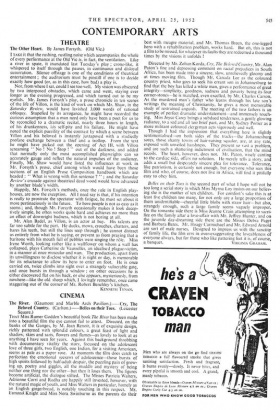CINEMA
The River. (Gaumont and Marble Arch Pavilion.) Cry, The
Beloved Country. (Carlton.)—Belles on their Toes. (Leicester Square.) THAT Miss Rumer Godden's beautiful book The River has been made into a beautiful film the eye cannot fail to attest. Directed, on the banks of the Ganges, by M. Jean Renoir, it is of exquisite design, richly patterned with splendid colours, a great feast of light and shadow, skies and saris, flowers and flames—as lovely to look at as anything I have seen for years. Against this background throbbing with documentary vitality the story, focussed on the adolescent love of three girls, two English, one Indian, for a visiting American, seems as pale as a paper rose. At moments the film does catch to perfection the emotional seesaws of adolescence—those bursts of high spirits followed by half-adult despair, the puzzling pain of grow- ing up, poetry and giggles, all the muddle and mystery of being neither one thing nor the other—but then it loses them. The figures become artificial, the dialogue stilted. The Misses Patricia Walters, Adrienne Corri and Radha are happily still invested, however, with the natural magic of youth, and Miss Walters in particular, homely as an English gingerbread, is notably touching in this respect. Mr. Esmond Knight and Miss Nora Swinburne as the parents do their
best with meagre material, and Mr. Thomas Breen, the one-legged hero with a rehabilitation problem, works hard. But oh, this is not a film to be missed, for whatever its faults they are redeemed a thousand times by the visions it unfolds !
Directed by Mr. Zoltan Korda, Cry, The Beloved Country, Mr. Alan Paton's fine and depressing comment on racial prejudices in South Africa, has been made into a sincere, slow, unrelievedly gloomy and at times moving film. Though Mr. Canada Lee as the coloured country priest, who goes to seek his errant son in Johannesburg to find that the boy has killed a white man, gives a performance of great integrity—simplicity, goodness, sadness and poverty being its four corner-stones—he is matched, even excelled, by Mr. Charles Carson. As the murdered man's father who learns through his late son's writings the meaning of Christianity, he gives a most memorable study of restrained anguish. The meeting of the two fathers is an example of perfect dramatic understatement—and immensely touch- ing. Miss Joyce Carey brings a subdued tenderness, a gently glowing radiance, to a sad and all too brief part, and Mr. Sydney Poitier as a more militant coloured clergyman acts vigorously and well.
Though I had the impression that everything here is slightly sentimentalised—on both sides of the tracks—the Johannesburg sores, those shanty towns of hair-raising squalor, are, at any rate, exposed with unveiled harshness. They present so vast a problem, and are such a shattering indictment of civilisation, that the mind recoils. The heart, however, does not. Mr. Paton, wisely canting to the cardiac side, offers no solution. He merely tells a story, and adds a small but desperately sincere plea for tolerance. Tolerance, like patriotism, is certainly not enough, but everyone who sees this film and who, of course, does not live in Africa, will find it pitifully easy to obey him.
Belles on their Toes is the second part of what I hope will not be too long a serial story in which Miss Myrna Loy insists on our believ- ing she is the mother of ten children. For comfort's sake this is at least five children too many, for not only are a large proportion of them unidentifiable—cheerful little blobs with straw hair—but also, strangely enough, such a large family seems vaguely improper. On the romantic side there is Miss Jeanne Crain attempting to sacri- fice on the family altar a love-affair with Mr. Jeffrey Hunter, and on the juvenile day-dreaming side there are the Misses Debra Paget and Barbara Bates. Mr. Hoagy Carmichael and Mr. Edward Arnold are sort of male nurses. Designed to impress us with the sanctity of family life, the film errs in over-exaggerating the loveableness of everyone always, but for those who like pattering feet it is, of course,


































 Previous page
Previous page